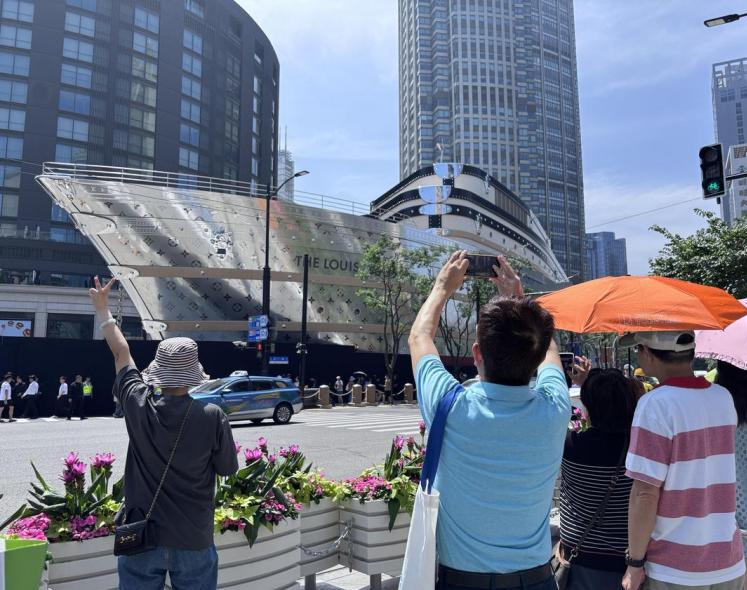
Despite the overall sluggish performance of the luxury goods market in China, the new landmark "Louis" created by the French brand Louis Vuitton (LV) in Shanghai after more than two months of construction officially opened on Thursday (June 26th), attracting a large number of people to visit and take photos.
The "Louis" is over 30 meters tall and looks like a huge ship. It is the first luggage box-shaped store of LV in China and also the largest brand home of LV worldwide.
Many Shanghai residents and tourists braved the scorching sun on Thursday morning to take photos with the new landmark at the intersection. It is understood that its total area is 1,600 square meters, featuring exhibitions, gift shops and restaurants. It will officially open to the public starting from Saturday (the 28th).
Mr. Liu, a retired citizen of Shanghai, came to visit especially early Thursday morning. In an interview with Lianhe Zaobao, he said that the building he actually saw was larger than what was shown in the photos and "the shape was very striking".
Wu Yue, president of LVMH Group in the Greater China region, said in an interview with the media that the world is currently in a year of great turmoil, facing macroeconomic difficulties, trade frictions, etc. "We believe that this huge ship symbolizes our unwavering confidence and will continue to sail on the sea."
Since the beginning of this year, the sales of luxury goods in China have continued to cool down. The financial report shows that in the first quarter of this year, LVMH Group's sales in the Asia-Pacific market dropped by 11% on a comparable basis. The contribution of this region to the group's performance decreased from 33% last year to 30%. Kering Group and Chanel also faced varying degrees of decline in their performances in China.
Shen Meng, executive director of Xiangsong Capital, pointed out in an interview that the decline in the performance of luxury brands in China is mainly due to the decline in purchasing power of the middle class. He said that the purchasing power of the core consumer group of luxury goods is relatively stable, but the middle class, as an incremental market, has been affected by economic fluctuations and its demand has shrunk rapidly.
Shen Meng analyzed that LV's launch of the new generation of flagship stores is precisely a strategic adjustment in response to changes in market demand. Large flagship stores can target high-end groups, better meet core demands, help maintain stable performance, and at the same time avoid the increased costs caused by scattered store openings. The impetus to open more stores, cover more regions and new consumer groups has been weakening.
In addition to concentrating resources on opening new stores, LV also announced its entry into the beauty market in March this year and plans to open its first beauty brand store in Nanjing.
Shen Meng said that for a comprehensive luxury goods group like LV, it is not realistic to scale back its business lines on a large scale. Instead, increasing product categories can better utilize its network and resources.
As for the trend of the luxury goods market in China, Shen Meng pointed out that if there are no signs of improvement in the Chinese economy in the short term, it is unlikely that the performance of luxury brands in China will rebound.

Recently, HP announced that it expects to cut 4,000 to 6,000 jobs worldwide by fiscal year 2028 as part of a plan to simplify operations and use artificial intelligence to accelerate product development, improve customer satisfaction, and enhance productivity.
Recently, HP announced that it expects to cut 4,000 to 6,00…
Recently, according to people Media, McDonald's announced t…
In the Geneva negotiation hall that day, by the time coffee…
On the evening of November 25th local time, the three major…
Amidst the intensifying global geopolitical conflicts and t…
As ESG concepts evolve and regulatory scrutiny intensifies,…